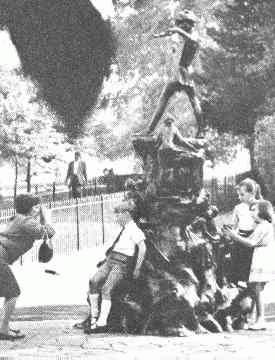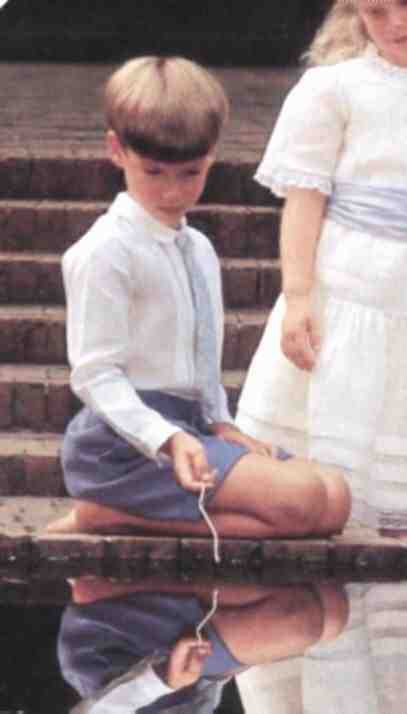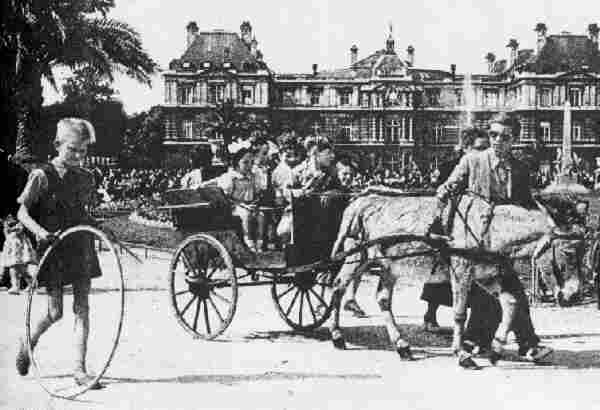
Boys' Clothes for Outings to the Park: The Post War Era

Figure 4.--Visits to the large urban parks continued to be popular afternoon activities as late as the 1950s and 60s, although nannies and governesses have become much less common. This boy smartly dressed in white knee socks and strap shoes is having his photograph taken by the famous Peter Pan sculpture in Hyde Park.
|
The traditional part outing has declined in our modern era. One does not go to the park to show off ones wardrobe. Boys for their part have many more diverting opportunities available to them. Visits to the park, however, have not totally disappeared. Clothing conventions have also changed in that casual clothes are now the order of the day.
Park Outings
Park usuage has varied greatly in the modern era. Many early parks had rules which discouraged usage by working class families. This has chaged in our more more democratic modern era. The tradition of nannies taking children to the park declined after World War II, except for the very youngest children. A variety of factors were involved. The even more devestating results of World War II meant that few but the really wealthy could afford nannies. More mothers worked and had less time or opportunity for trips to the park. Gradually it became more accepted to enroll younger children in day care.

Figure 2.--Outings to the park have declined as social events in our modern era as have formal clothing. These outings, however, have not totally disappeared.
|
The changing experience of childhood also modified park usage. The modern child is enrolled in dance and music lessons, participates in sports and scouting and a hiost of other activities. The park simplly does not appeal as it once did. In addition, the busy modern child, like his parents does not have the time he once did. Another factor that a child's home is now equipped with television, computerbgames, and many other diversions that were once not availaable.
In more recent years we have the added problem--especially in America--of parks being unsafe for adults, let alone children. Usage of the great public parks changed as a result of rising crime. Another factor was that school children who could once beallowed to go to the park or ride their bike with friends, increasingly had to have their activities more carefully supervised for saftey sake.
Clothing
Some parents still dressed up children for par visits in the 1950s and early 60s.
Boys wearing smart short pants and knee socks--but not suits could be seen in
big-city parks until the 1960s.
The trend was toward casual clothes. It was noticeable in the 1950s and even more so the 1960s. Available French images in particular show this trend. Boys wear short sleeved shirts and short pants, often with sandals and short socks or no socks at all. Of course American boys wanted to wear their jeans to the park. Only in the 1970s did the increasing popularity of short pants for casual summer way result in more and mlore American boys wearing shorts to parks.
Casual short pants and jeans were the order of the day by the 1970s. One no longer dressed up to go to the park either or adults. In fact, increasingly the fashion was to dress down as much as possible for park outings.
Theme Parks
The foreruners of the modern theme parks appeared in the late 19th century, place like Coney Island. They were the anthisis of the staid municipal parks which began to apeear in the mid-19th century. Complete with diversions and rides like ferris wheel and roller-coasters, they breathed excitementm unlike the more esthetic pleasures of greenm labscaped parksd. But it was theme parks that boys wanted. Disbeyland which opened in the 1950s was the prototype. Many more followed in America and in countries around the world.
American boys mostly wore jeans to Disneyland when the park opened in the 1950s. This did not significantly change until the 1970s, by which time cut-offs were all the rage. By the 18980s, boiys in wearing short ponts often out numbered those in long pants. This has continued into the 1990s, although by the end of the dcade, short pants were short in namer only.

Figure 3.--This post-war photograph shows the Luxembourg Palace Gardens in Paris. Thevboy wears a sleevless sweater and casual shirt with short pants. It was taken about 1951. Note the classic hoop he is playing with.
|
Changing Nature
Many early parks, like Central Park, in New York had strict rules about how the park could be used. Ball games were strictly prohibited. The idea of the early parks was to comune with fresh air and nature, not for strenous competive sports. Many of these rules continued until after World War II. Finally staid park authorities had to bend to popular taste. Many chabnges followed. Areas of parks were turned over for sport. One of the earlist and popular were tennis courts, but baseball fields and for Little League eventually even soccer fields followed. Earlyu parks had had briddle paths for the wealthy. Modern parks added jogging and bike paths. Skates were popular in the 1920s, although by the 1950s they were more for girls, at least in America. Skates reappeared in the 1990s, but the modern incarnation were in-linecskates that both boys and girls--as well as adults--enjoyed.
Christopher Wagner
histclo@lycosmail.com
Navigate the Boys' Historical Clothing Web Site:
[Return to theMain activities page]
[Return to theMain park outing page]
[Introduction]
[Chronology]
[Clothing styles]
[Biographies]
[Bibliographies]
[Contributions]
[Boys' Clothing Home]
Navigate the Boys' Historical Clothing Web Site:
[Sailor suits]
[Sailor hats]
[Buster Brown suits]
[Eton suits]
[Rompers]
[Tunics]
[Smocks]
[Pinafores]
Created: July 10, 1998
Last updated: July 10, 1998




